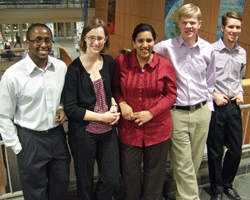You reached this page through the archive. Click here to return to the archive.
Note: This article is over a year old and information contained in it may no longer be accurate. Please use the contact information in the lower-left corner to verify any information in this article.
Twin Cities turn to students for transportation analysis
February 24, 2010
Are St. Olaf students equipped with the knowledge and skill to solve the problems of the professional world? Recently, five St. Olaf math students proved themselves so, solving an issue that the Transit for Livable Communities Bike Walk staff of the Twin Cities has been contemplating for years.
The TLC program is part of the Non-Motorized Transportation Pilot federal initiative that promotes biking and walking. While models exist for measuring vehicular transit, measuring biking and walking is not as easy to gauge mathematically.
 |
| St. Olaf senior mathematics majors (L-R) Ian Gacheru, Deidre Kiefer, Briana Griffin, Bryant Torkelson, and Jonathan Woolums spent January creating a model for transportation analysis that has grabbed the attention of the U.S. Department of Transportation. |
This fall, St. Olaf Mathematics Professor Steve McKelvey and Assistant Mathematics Professor Urmila Malvadkar invited the Bike Walk staff to submit a quantitative problem for the winter Mathematics Practicum. Five senior math students took on the challenge to invent a model for measuring biking and walking traffic. Briana Griffin, Jonathan Woolums, Bryant Torkelson, Ian Gacheru and Deidre Kiefer worked together under the loose guidance of the professors to analyze the problem.
"The main task of the project was to understand and correct a proprietary model that estimated cycling and walking activity in Minneapolis," Gacheru said. "The first week we spent most of our time trying to understand and correct the model. The next two weeks we started working on creating a new survey that would complement the model we'd revised."
The five students met throughout January. "We met with the group daily, making sure they remained focused on both short- and long-term goals. The course professors did very little of the actual mathematics, leaving that entirely up to the students," McKelvey said.
Presentation
At the end of the month, the students presented their research to the TLC office in St. Paul, which included suggestions for counts and surveys that the Bike Walk staff plans on using in upcoming years. Additionally, a web conference was arranged so that colleagues at the United States Department of Transportation located in various parts of the country could listen in and question the students.
 |
| Steve McKelvey |
"Watching them present their work and talents in a public venue and seeing the overwhelmingly positive response from the off-campus audience always leaves me feeling proud to be associated with such a special group of young people," McKelvey said. "As a faculty member, it is great fun to watch the sponsor's faces as the student presentations unfold and the sponsors realize that they are in for something truly useful, professional, and first-rate."
Faculty and students alike were satisfied with the successful outcome of the project. "I had such a rewarding experience working on this project for TLC," Kiefer said. "We were able to directly apply classroom knowledge we have gained at St. Olaf to a 'real-world' issue. The comments we received after our oral presentation at TLC’s office reassured us that the work we did over January will be helpful for the four pilot communities that are currently part of the Nonmotorized Transportation Pilot Program and, hopefully, future communities."
Bike Walk Twin Cities claims it is fueled by "people power." To decrease gas emissions, people power is definitely needed. But to solve the math behind it, a little brain power can come in handy too.
